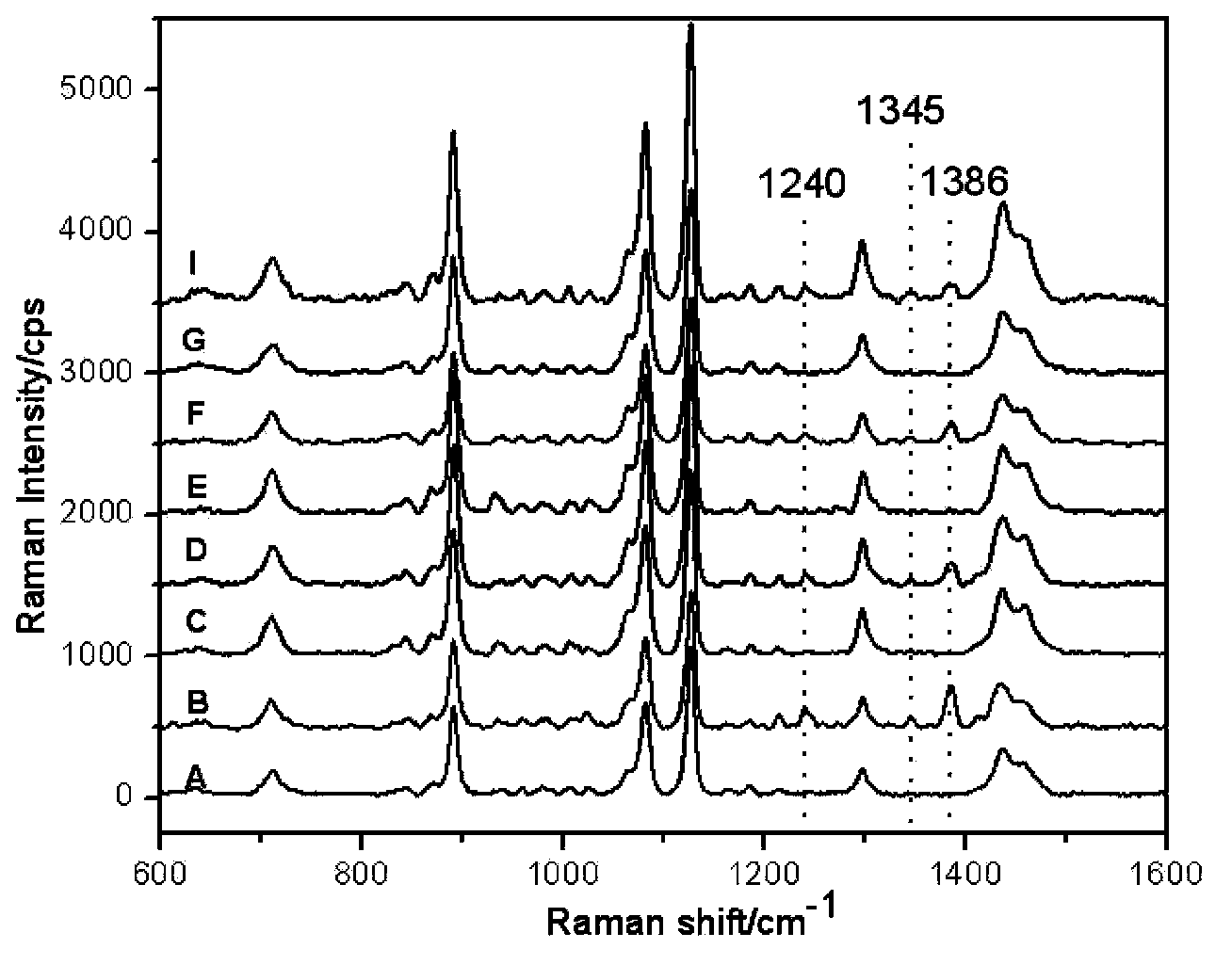Analysis and detection method of surface enhanced Raman of benzo (a) pyrene
A surface-enhanced Raman and detection method technology, applied in Raman scattering, material excitation analysis, etc., can solve the problems of weakened SERS enhancement effect, easy oxidation, unstable silver film, etc., and achieve simple production, uniform particle size, Prepare simple effects
- Summary
- Abstract
- Description
- Claims
- Application Information
AI Technical Summary
Problems solved by technology
Method used
Image
Examples
Embodiment 1
[0034] 1) Synthesis of gold nanoparticles with a particle size of 55±10nm:
[0035] Take 200mL of a 0.01% aqueous solution of chloroauric acid in a 250mL round bottom flask, heat it to boiling under reflux under magnetic stirring, then quickly add 1.4mL of a 1% aqueous solution of sodium citrate, and the solution will change within half a minute. Black, continue to reflux heating for 40min, the solution gradually changes from light yellow to brownish red, let it completely react and cool to room temperature naturally, then you can get a gold nanoparticle sol with a diameter of about 55 ± 10nm (see figure 1 ).
[0036] 2) Gold nanoparticles self-assemble into a SERS active substrate:
[0037] Concentrate the gold sol synthesized in 1) by centrifugation, wash and centrifuge once with ultrapure water (both centrifugation conditions are 8000r / min, 10min). Take 1mL of the concentrated gold nanoparticle solution in a clean small crucible, and then add 200 μL of 1mmol / L n-dodecanet...
Embodiment 2
[0042] 1) Synthesis of gold nanoparticles with a particle size of 55±10nm:
[0043] Take 200mL of a 0.01% aqueous solution of chloroauric acid in a 250mL round bottom flask, heat it to boiling under reflux under magnetic stirring, then quickly add 1.4mL of a 1% aqueous solution of sodium citrate, and the solution will change within half a minute. black, continue to reflux heating for 40min, the solution gradually changes from light yellow to brownish red, let it completely react and then naturally cool to room temperature to obtain a gold nanoparticle sol with a diameter of about 55 ± 10nm.
[0044] 2) Gold nanoparticles self-assemble into a SERS active substrate:
[0045] Concentrate the gold sol synthesized in 1) by centrifugation, wash and centrifuge once with ultrapure water (both centrifugation conditions are 8000r / min, 10min). Take 1mL of the concentrated gold nanoparticle solution in a clean small crucible, and then add 200 μL of 1mmol / L n-dodecanethiol-methanol soluti...
Embodiment 3
[0052] 1) Synthesis of gold nanoparticles with a particle size of 55±10nm:
[0053] Take 200mL of a 0.01% aqueous solution of chloroauric acid in a 250mL round bottom flask, heat it to boiling under reflux under magnetic stirring, then quickly add 1.4mL of a 1% aqueous solution of sodium citrate, and the solution will change within half a minute. black, continue to reflux heating for 40min, the solution gradually changes from light yellow to brownish red, let it completely react and then naturally cool to room temperature to obtain a gold nanoparticle sol with a diameter of about 55 ± 10nm.
[0054] 2) Gold nanoparticles self-assemble into a SERS active substrate:
[0055] Concentrate the gold sol synthesized in 1) by centrifugation, wash and centrifuge once with ultrapure water (both centrifugation conditions are 8000r / min, 10min). Take 1 mL of the concentrated gold nanoparticle solution in four clean small crucibles, and then add 100 μL, 200 μL, 300 μL, and 400 μL of 1 mmol...
PUM
| Property | Measurement | Unit |
|---|---|---|
| Particle size | aaaaa | aaaaa |
| Wavelength | aaaaa | aaaaa |
Abstract
Description
Claims
Application Information
 Login to View More
Login to View More - Generate Ideas
- Intellectual Property
- Life Sciences
- Materials
- Tech Scout
- Unparalleled Data Quality
- Higher Quality Content
- 60% Fewer Hallucinations
Browse by: Latest US Patents, China's latest patents, Technical Efficacy Thesaurus, Application Domain, Technology Topic, Popular Technical Reports.
© 2025 PatSnap. All rights reserved.Legal|Privacy policy|Modern Slavery Act Transparency Statement|Sitemap|About US| Contact US: help@patsnap.com



